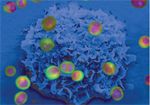Lab-on-a-Chip Sensor Rapidly Diagnoses Oral Cancer
Wedding high technology to recent advances in understanding the molecular biology of oral squamous cell carcinoma
AUSTIN, Texas-Wedding high technology to recent advances in understanding the molecular biology of oral squamous cell carcinoma, a University of Texas research team has developed a prototype sensor that can diagnose the most common form of oral cancer in about 10 minutes without a biopsy.

Oral cancer cells shown in pink by epifluoresence imaging are overlaid on a SEM image of a single cell from a suspicious oral lesion on a membrane. Image reproduced by permission of Dr. John McDevitt and The Royal Society of Chemistry from Weigum et al:
Lab on a Chip
7(8):995-1003, 2007.
The fully automated lab-on-a-chip measures levels of the epidermal growth factor receptor (EGFR), which is overexpressed by oral cancers. The researchers are now expanding the sensor's detection powers to include other proteins and genes that serve as biomarkers for the cancer before they begin clinical trials.
"It could take several months to more than a year before we make the transition," said senior author John T. McDevitt, PhD, professor of chemistry and biochemistry. "But the diagnostic platform has been built, and it's just a matter of fine tuning the components that are already in place."
In evaluating the device, he and his colleagues compared the expression of EGFR in three cell lines of oral cancer with expression in healthy cells. They found that the cancer cell lines produced significantly higher levels of the receptor than did the controls. The sensor results correlated well with those from flow cytometry, regarded as the gold standard for measuring protein expression.
Completing each test run of the sensor took about 9 minutes, from collecting a sample to display of the results. The researchers reported their findings in Lab on a Chip, a journal of The Royal Society of Chemistry (7:941-1080, 2007).
Currently, most diagnoses result from biopsies performed after a physician or dentist notices an oral lesion. However, providers may hesitate or delay referring some patients because the biopsy is painful and a negative result may upset a patient. Dr. McDevitt envisions the lab-on-a-chip speeding diagnoses and finding more oral cancers in their precancerous and early stages.
Speed and efficiency
"What's exciting is the speed and efficiency that this test will bring to the diagnostic process," he said. "No longer will patients need to endure referrals, long waits for test results, and scheduling follow-up consultations."
The new portable device, about half the size of a toaster, analyzes cells brushed from suspicious oral lesions. The cells are suspended in a fluid and approximately one drop of the mixture is loaded into the device, which conveys the liquid down a microchannel to a tiny chamber, where the cells stick to a membrane (see cover image). The cell-less fluid drains out through tiny openings, and a mixture of antibodies tagged with fluorescent dye is pumped into the chamber to seek out and attach to EGFRs on the cells.
"We can then read the level of fluorescence and determine how much EGFR is present on the cell surface," said first author Shannon E. Weigum, a PhD candidate in Dr. McDevitt's lab. The sensing device "automates a process that is done now by a pathologist. Think of the test as pathology on a chip."